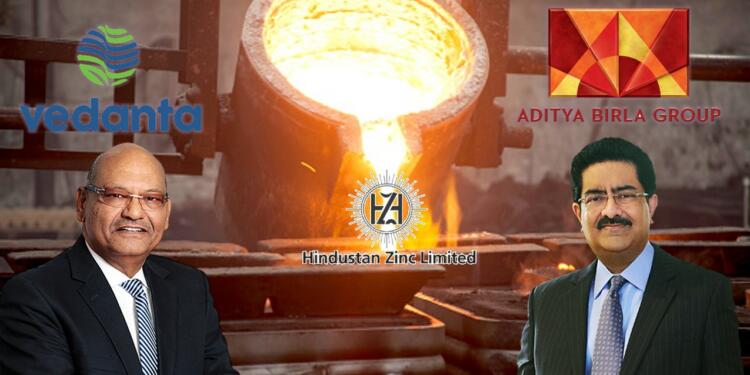As Prime Minister Modi is keenly engaging big corporates in India’s developmental story, the competitive instinct between corporate houses has started to grab the limelight. Mangalam Birla’s recent regret over acceding Hindustan Zinc Ltd to Vedanta Group is a shining example of that.
Birla expresses his sadness over losing HZL:
Kumar Mangalam Birla, the owner of Aditya Birla Group, recently expressed his dissatisfaction over not being able to acquire the ownership of Hindustan Zinc Limited (HZL), an Indian integrated mining and resources producer.
Birla was addressing an interactive session with the Indian Chamber of Commerce (ICC). Expressing his decade-long pain over losing the fourth-largest zinc-lead smelter (HZL) in the world, Birla said “Hindustan Zinc we actually lost out very relatively, and I think we just missed some details in the due diligence that we did. So, the learning from it that I have taken away is that the devil is in the details. We missed by a whisker. It could have been a great investment to add…I think there is no end to the detailing that you can do, which is the smart thing to do,”
Vedanta holds a majority stake in HZL:
Currently, Hindustan Zinc Ltd is held by Vedanta Group led by Anil Aggarwal. Vedanta holds a majority stake in the company with total ownership of 64.92 percent, while 29.54 percent is held by the Government of India.
HZL is the world’s second-largest zinc producer. In terms of smelting Zinc, it is the fourth largest Zinc smelter in the world. It is amongst the top 10 silver producers of the world.
HZL – An erstwhile government company now providing revenues to the government through disinvestment:
Though now a majorly private-owned country, HZL has a 77-year long history to boast of. The company first came into existence in pre-independence India in 1944. It was named Metal Corporation of India.
HZL was incorporated in 1966 from the erstwhile Metal Corporation of India. At the time of incorporation, it was solely a public sector undertaking (PSU). Public sector undertakings are fundamentally commercial ventures owned by the government. For more than 25 years, it fulfilled the various socialist governments’ projects of mining and producing zinc, lead, silver, and cadmium.
Government started to disinvest it in tranches after 1991:
As India started to open its market for the world, the demand for decreasing control on PSUs started to catch heat. The ownership of HZL by the government of India also came under attack. Thus, the government decided to cease its control of the mining company. However, the Government showed no hurry in disinvesting the company and decided to do it in batches.
- In the first cluster of disinvestment, the Government released08 percent of its share in the market. 12.54 percent was acquired by financial institutions, 7.58 percent by corporate bodies and non-resident Indians, and 3.96 percent by Indian nationals. HZL was also listed on the stock exchange.
- In the second tranche, Shri Atal Bihari Vajpayee decided to disinvest 26 percent of the share. On April 4, 2002, the government executed a shareholders’ agreement and share purchase agreement with Sterlite Opportunities & Ventures Ltd (SOVL), the strategic partner chosen by the government
- Within one week, SOVL ended up acquiring another 20 percent of the shares held by the Government of India. They did it through a mandatory offer from the open market.
- In August 2003, SOVL thrust its authority on 18.92 percent of the shares owned by the Government through the call option. The transfer was finalized in November 2003. With this, the company became the owner of 64.92 percent shares of HZL.
- Later, the Government of India decided to invest its remaining 29.54 percent residual shareholding in the company.
Hurdles in disinvestment proceedings:
However, the disinvestment process was not easy.
- In November 2003, a PIL was filed against the transfer of 26 percent share to SOVL by the Atal Bihari Vajpayee government. It was later dismissed by the Supreme Court in 2008.
- In October 2012, Maton Mines Mazdoor Sangh filed a writ challenging the disinvestment of residual shareholding by the Government of India. However, it was dismissed within a month by the Supreme Court.
- Finally, in February 2014, the National Confederation again went to court against the disinvesting of 29.54 percent of residual shares. The petitioner also requested for CBI inquiry into the disinvestment of 26 percent.
In a recent order, Supreme Court has allowed the central government to divest the remaining 29.54 percent residual shareholding. It is widely believed that since Vedanta Group owns the majority of the share, it will be chosen for the ownership of the remaining 29.54 percent of the share to be disinvested by the Modi government.
The huge empire of HZL will help Vedanta to revive its metal business:
HZL operates the world’s third-largest open-pit mine, and the World’s largest Zinc Mine in Rampura Agucha, Rajasthan with total zinc and lead production capacity of 10 lakh tonnes. The company is such huge in its financial parameters that only 29.54 percent of disinvestment will send Rs 40,000 crores into government coffers.
Read more: Rupees 89,992,20,00000: What Sterlite Copper Plant shutdown has cost India in 3 years
After the loss of a major part of its copper business in India, the ownership of HZL will come off as a huge booster dose for Anil-Agarwal led Vedanta. The company which once produced 40 percent of India’s copper will now establish its monopoly in other metals as well.































